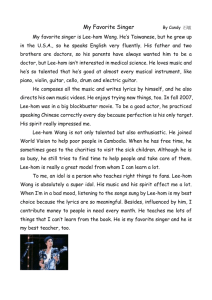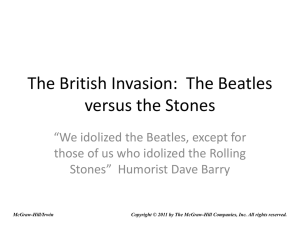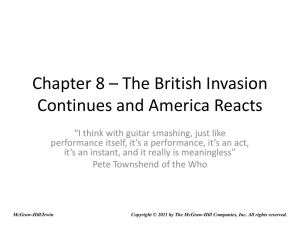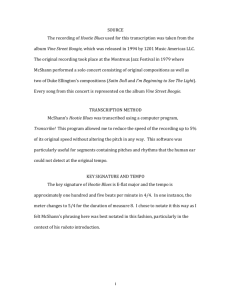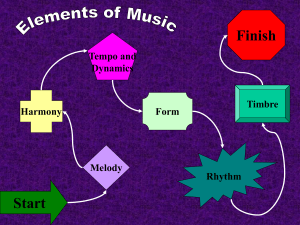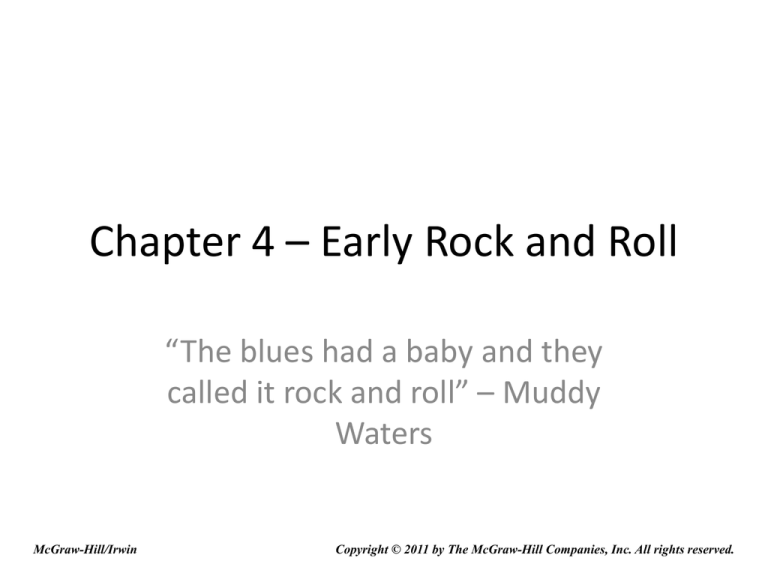
Chapter 4 – Early Rock and Roll
“The blues had a baby and they
called it rock and roll” – Muddy
Waters
McGraw-Hill/Irwin
Copyright © 2011 by The McGraw-Hill Companies, Inc. All rights reserved.
Musicians with Backgrounds in
Country Music
Bill Haley (1925-1981)
1951- Bill Haley and the Saddlemen covered blues songs
1952- group name changed to the Comets
1954- covered Joe Turner’s blues song “Shake, Rattle and
Roll” with lyric changes to remove sexual references
1955- biggest hit of career, “(We’re Gonna) Rock Around
the Clock”
1957- toured Britain, making Haley the first international
rock star
4-2
Listening Guide
“Shake, Rattle and Roll” by J. Turner (1954)
Tempo: 140 beats per minute, 4 beats per bar
Form: 12- bar blues
Features: Rhythm section includes boogie-woogie-styled piano,
string bass, hand clapping, and snare drum accents on the
backbeats
Fills by saxophones playing repeated notes or riff patterns
Instrumental 5th chorus by baritone saxophone using jazzstyled improvisation
Ending, saxophone quoting from Ellington’s “Take the ‘A’ Train”
Lyrics: The lyrics include many sexual references about the singer’s
appreciation of a woman
Charts: R&B, #1 for three weeks
4-3
Listening Guide
“Shake, Rattle and Roll” by Bill Haley and the Comets (1954)
Tempo: 176 beats per minute, 4 beats per bar
Form: 12-bar blues
Features: Rhythm section includes piano and drums playing a
shuffle beat pattern and bass snapping the strings against the
fingerboard
Backbeat less accented than in Turner’s recording
Fills by saxophone and guitar riffs (repeated patterns)
Lyrics: Similar to the lyrics in Turner’s recording except that the
sexual references are missing and replaced by ones that
indicate that the woman is cold and no longer loving the singer
Charts: Pop, #7, British hits, #4
4-4
Listening Guide
(1935-1977), singer, guitarist
Known as the King of Rock and Roll
1954 - Signed to Sun Records by owner/producer Sam Phillips
1955 - Turned down in audition for Grand Ole Opry because style was too
“black”
1955- Turned down in audition for TV show Talent Scouts
1955 – signed with manager Colonel Tom Parker, changed to RCA record
label
1956 – RCA’s polished studio recording sound, songs by a variety of pop
writers, much publicity and TV show performances, first movie, Love
Me Tender, and international stardom
1957 – bought Graceland and made movies Loving You and Jailhouse Rock
1958 – movie King Creole, entered the U.S. Army for two years
1960s and beyond – more movies and hit songs from movies, as well as
performances in Las Vegas and other places
1977 – Reclusive life and drug-related death
4-5
Listening Guide
“Hound Dog” by Willie Mae “Big Mama” Thornton (1952)
Tempo: 140 beats per minute, 4 beats per bar
Form: 12- bar blues
Features: Thornton uses a rough, classic blues-style tone quality
Rhythm section – country blues-style guitar rhythms, bass on
beats, and hand clapping with a drum stuck on the side for a
strong backbeat
Fills by guitar bending strings to produce blue notes
Lyrics: A man has cheated on the singer and she vows to stop
seeing him
Charts: R&B, #1 for seven weeks
4-6
Listening Guide
“Hound Dog” by Elvis Presley (1956)
Tempo: 176 beats per minute, 4 beats per bar
Form: 12-bar blues
Instrumental choruses played by guitar with vocal group
singing sustained chords
Features: Presley uses a polished urban blues style and tone quality
Rhythm section- country-style guitar, bass in riff pattern,
drums accent strong backbeat
Fills by guitar and sustained vocals
Lyrics: Sung to a woman who is of no more value than a hound dog
that cannot catch rabbits
Charts: Pop, #1 for eleven weeks, R&B, #1 for six weeks, British
hits, #2
4-7
Rockabilly
Style made popular through Presley’s early recordings at
Sun Records in 1954-55
Typical rockabilly instrumentation:
electric lead guitar
acoustic rhythm guitar
slapping bass fiddle
subdued drums accent back beat
Carl Perkins (1932-1998), singer, songwriter, guitarist
Attracted to Sun Records to record rockabilly after
hearing Presley’s records
4-8
Listening Guide
“Blue Suede Shoes” by C. Perkins (1956)
Tempo: 168 beats per minute, 4 beats per bar
Form: 12-bar blues with some pickups and some extensions
Features: Some use of “stop time” (vocals continue while
instruments “punch” in at certain beats for rhythmic interest)
Rockabilly instrumentation, electric lead guitar, acoustic
rhythm guitar, slapping bass, and drums
Lyrics: Singer values his blues suede shoes over anything else
Charts: Pop, #2 for four weeks, R&B, #2 for four weeks, Country, #1
for three weeks, British hits, #10
4-9
Jerry Lee Lewis
(1935- ), rockabilly pianist/singer
Attracted to Sun Records by Presley’s rockabilly recordings
Covered blues records – “Whole Lotta Shakin’ Goin’ On,” originally
by Big Maybelle
Wild piano style using glissandos (sliding runs), stood up, played
with his feet, jumped inside the piano to sing.
Called self “the Killer”
Career temporarily ruined after illegal marriage to 13-year-old
cousin became known
Eddie Cochran (1938-1960), songwriter, guitarist, multiinstrumentalist, pioneer in overdubbing techniques, rockabilly style
and more pop style for last hit “Three Steps to Heaven”
Death in car crash, 1960
4-10
Listening Guide
“Summertime Blues” by E. Cochran (1958)
Tempo: 152 beats per minute, 4 beats per bar
Form: Eight bar sections in ABABAB order
Instrumental beginning and ending
Features: Cochran has recorded and dubbed (added to the
recording) all parts – vocal, acoustic rhythm guitar, string bass,
hand clapping, and drums
Rhythmic pattern of four even beats with a double accent on
the second beat of each bar
Lyrics: The singer is in agony when he should be having fun and
everyone forces him to work
Charts: Pop, #8, R&B, #11, British hits, #18
4-11
Gene Vincent
(1935-1971), rockabilly singer/guitarist
biggest hit – “Be-Bop-A-Lula” (1956)
The Everly Brothers (Don born in 1937 and Phil born in 1939)
Country-influenced rock style, more pop in early 60s
Buddy Holly (1938-1959), songwriter, singer, guitarist
Popularized the use of the solid-body electric guitar
1956-1958 with the Crickets
1958 – moved to New York to start new songwriting and recording career
in more pop style (last record, “It Doesn’t Matter Anymore” included
bowed string section
1959 – Final tour, death along with Ritchie Valens and the Big
Bopper
4-12
Listening Guide
“Peggy Sue” by B. Holly and the Crickets (1957)
Tempo: 148 beats per minute, 4 beats per bar
Form: modified 12-bar blues
4-bar introduction and ending
Features: Instrumentation- electric solid-body guitar, acoustic rhythms
guitar, string bass, and drums
Holly strums his guitar at a very low volume during vocals, but is
more clear with strumming and melodic fills during the instrumental
chorus
The drums keep an energetic four-to-the-beat pattern on tom-toms
with little or no accent on the backbeat
Holly’s vocals include his characteristic vocal hiccup
Lyrics: This singer is in love with Peggy Sue
Charts: Pop, #3, R&B, #2, British hits, #6
4-13
Musicians with Rhythm and Blues
Backgrounds
Fats Domino (born in 1929), songwriter, singer, pianist
Style based on New Orleans’ rhythm and blues
1950 – first hits on R&B charts
1955 - first pop-chart hit “Ain’t That a Shame”
Wrote songs and performed with
bandleader/producer Dave Bartholomew
1956 - Style varied from smooth rhythms of “Blueberry
Hill” to the rollicking boogie-woogie of “I’m
Walkin’”
1963 – semi-retirement from performing, having had
37 top-40 hit records
4-14
Listening Guide
“I’m Walkin’” by Fats Domino (1956)
Tempo: 224 beats per minute, 4 beats per bar
Form: 4-bar introduction, AABA with 8-bar periods
Features: Uneven beat subdivisions
Backbeat hand clapped and also supported by drums
Repeating bass pattern
Instrumental features growl-toned tenor saxophone
solo
Lyrics: Walking is symbolic of the singer’s attempt to get his
girl back.
Charts: Pop, #4, R&B, #1, for six weeks, British hits, #19s
4-15
Chuck Berry
(1926- ), singer, songwriter, guitarist
Songs captured teenaged spirit and celebrated
rock and roll
Duckwalk in performances
Known as the Father of Rock Guitar
1962-64 Prison term
1986 movie Hail, Hail Rock ‘n’ Roll
4-16
Listening Guide
“School Day” by Chuck Berry (1957)
Tempo: 148 beats per minute, 4 beats per bar
Form: 12-bar blues
Features: Uneven beat subdivisions, drums and guitar fills
play shuffle beat
Backbeat accented minimally
Guitar fills often imitate vocal lines
Piano plays subtle rhythmic background
Lyrics: Teenagers need to follow the drudgery of school by
dancing to rock and roll music
Charts: Pop, #3, R&B, #1 for five weeks, British hits, #24
4-17
Little Richard
(1932- ), songwriter under real name Penniman,
singer, pianist
Fast tempos and high energy level
Androgynous hairstyle and heavy facial makeup
1957 – Quit rock and roll to become a preacher
1962 – Performed on bills with the Beatles in
England
1964 – Some U.S. appearances
1986 – New recordings, commercials and movie
rolls
4-18
Listening Guide
“Long Tall Sally” by Little Richard (1956)
Tempo: 176 beats per minute, 4 beats per bar
Form: 12-bar blues
Features: The piano plays a shuffle beat
Stop time used by instruments
A tenor saxophone improvises a solo imitating Little
Richard’s rough vocal style
Lyrics: Uncle John is caught having sex and the singer
hopes to as well
Charts: Pop, #6, R&B, #1 for eight weeks, British hits, #3
4-19
Discussion questions
In what ways were the music and images of these
performers rebellious for their time? What would those
same performers have to do to maintain their rebellious
reputations today?
Does Elvis Presley deserve the title “King of Rock and Roll”?
What about Bill Haley or Chuck Berry?”
How did the race of performers affect their popularity, or
did race matter to most fans?
4-20


